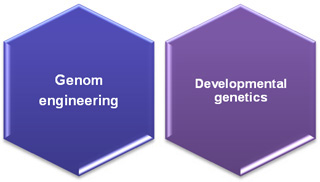

The major focus of the Division of Developmental Genetics is the development of technique for mouse genome engineering and analyses of genetically modified mice.
1) Site-specific recombination & genome editing techniques.
Cre/lox site-specific recombination system has been widely used in genome engineering of mouse and ES cells. We have developed efficient Cre-mediated integrative recombination system in mouse ES cells using several kinds of mutant lox sites. This integrative recombination is quite useful for the production of transgenic animals or cells, because any DNA of interest can be introduced into a chromosomally located lox site. We are also using the CRISPR/Cas9 system in fertilized eggs and ES cells to induce deletion and/or homologous recombination at high frequency.
2) Exchangeable gene trap clones (EGTC).
We have developed an exchangeable gene trap method that was optimized for post-insertional modification using a Cre/mutant lox recombination system. Our trap vector carries a SA and the promoterless
β-galactosidase/neomycin-resistance fusion gene (β-geo) and three stop codons that are located before the β-geo start codon. Over 2000 trap clones have been isolated and identified their trapped gene by 5’RACE. We focus on clones trapping non-cording RNA genes. Thirteen trap lines have been selected, established mouse lines and analyzed the expression patterns and phenotypes.
3) Production and analysis of transgenic MSM/Ms mouse lines.
MSM/Ms is an inbred strain established from Japanese wild mice, Mus musculus molossinus and shows unique phenotypes different from usual laboratory mouse straines. We established a germline-competent ES cell line, Mol/MSM-1 from MSM/Ms blastocysts to modify MSM/Ms genome. Currently, we are analyzing transgenic MSM/Ms lines carrying an oncogene.
4) Analysis of the Danforth’s short tail (Sd) mutation.
Danforth’s short tail (Sd) is a semidominant mutation on mouse chromosome 2 characterized by spinal defects, urogenital defects, and anorectal malformations. We identified the insertion of an early transposon in the Sd candidate locus approximately 12-kb upstream of the Ptf1a gene. The insertion of an ETn induced ectopic expression of Ptf1a in the caudal region of the embryo, resulting in suppression of Cdx2 and its downstream target genes. We are analyzing the mechanism of ectopic expression of the Ptf1a gene in the Sd allele.
Our projects

- 2019/06/11Member updated.
- 2012/10/05The homepage was renewed.















